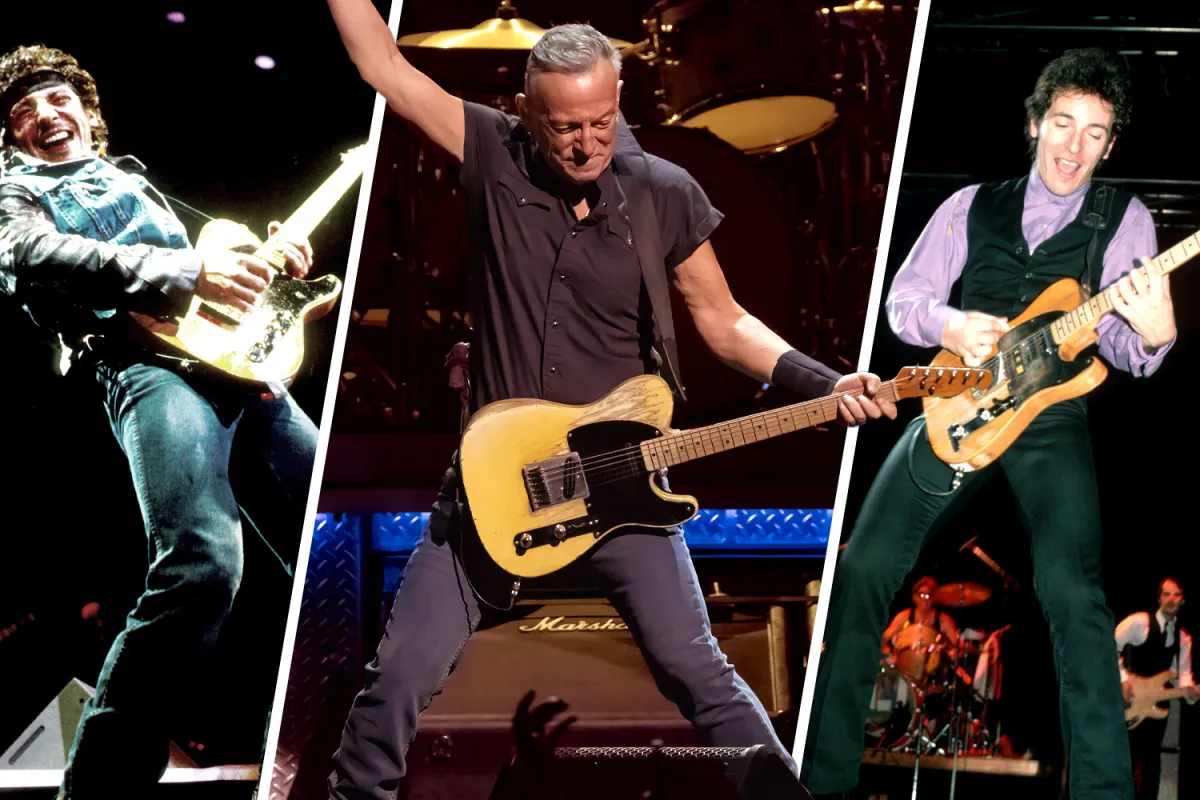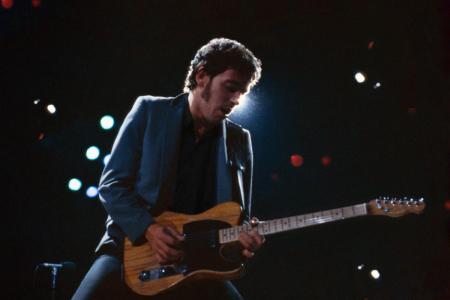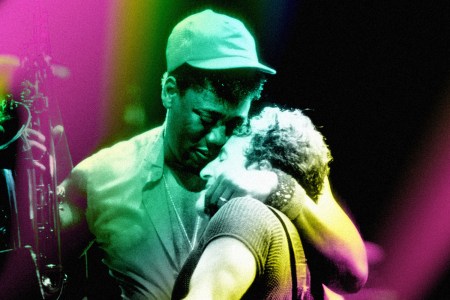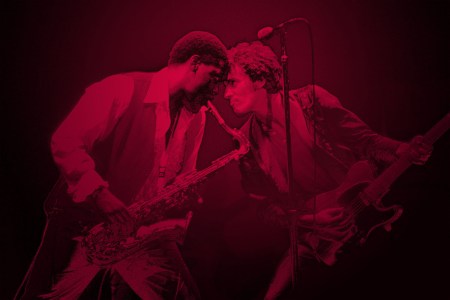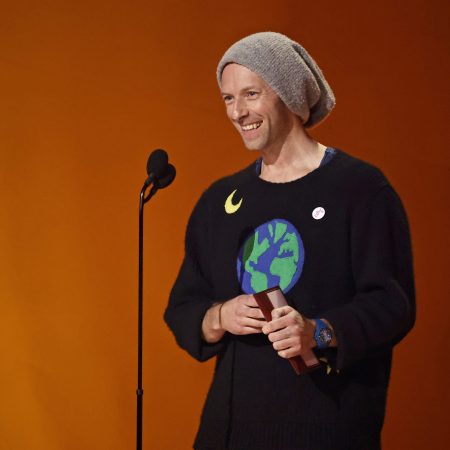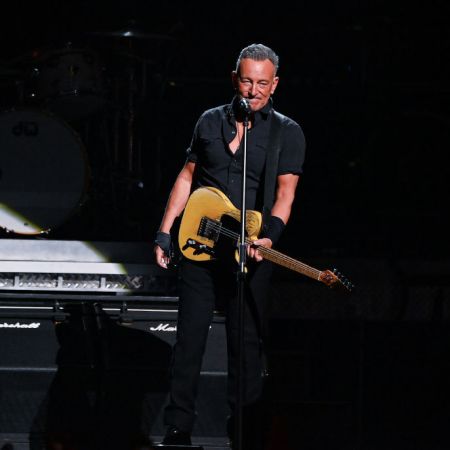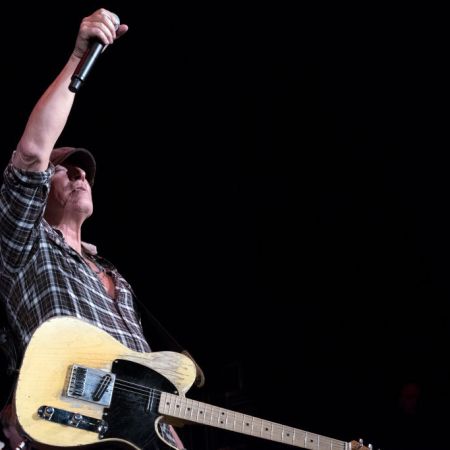If you’ve seen Bruce Springsteen in concert, you know. If you haven’t, you don’t. Regardless of your views on Springsteen’s politics or his unexpected recent transformation into Gordon Gekko, on stage, the man is electric. When I asked excitable boy and Outlaw Country DJ Mojo Nixon to tell me what he thinks, he didn’t hesitate.
“Bruce Springsteen is the greatest live performer since Al Jolson got on his knee and said ‘Mammy,’” he says. “Bruce Springsteen is the greatest live entertainer of the last 100 years. Bring it on. Who else you got?! You got somebody else?! Bring ‘em on. People say, ‘Oh, Dean Martin, oh Frank Sinatra, fill in the blank,’ No! Bruce.”
As someone who has witnessed Springsteen live more than 150 times, I can attest to the power and almost-religious experience that defines his extraordinary legacy. I’ve seen him all over this country, in Canada, in Sweden and in Italy. With the first leg of his current E Street Band world tour wrapped (I saw two shows), Springsteen now heads to Europe. His live mission continues to be the same as when he first began. This is what he told the audience at the MusicCares “Person of the Year” event in 2013: “I wanted to be great more than anything else, and I wanted to be important in your life. Because you keep us in search of the force that reignites our gifts, our ability to make you want to move, to dance, to love, to make love, to be angry, to act. When we play, we want the hair to stand up on your arms; we want you to feel the glory. And we want you to be glad of being alive.”
In honor of Springsteen’s enduring spirit, here’s a chronological list of his 18 most important performances — not necessarily the best or most memorable, but simply the 18 that had, arguably, the most impact on his career. Let the great debate ensue.
1. Elks Club with The Rogues in Freehold, NJ (1965)
In a 1975 interview for Playboy magazine, Bruce talked about his first associated band, The Rogues. While other former band members of The Rogues have yet to specifically recall exactly when Springsteen may have played with them, they do confirm at least a couple of Freehold gigs in the summer of ’65. Springsteen mentioned the band again in his 1976 lawsuit with his former manager as his first official band. While overall details of this brief period and specific show are sketchy at best, Springsteen has stated several times on E Street Radio that he recalls his first paid gig was, in fact, at the Elks Club for $5. And he says that was the best money he ever earned, “besides all the rest.” One thing is certain — a not-yet-16 year-old Bruce Springsteen had just become a professional musician. The dream had turned real.
2. Student Prince with Clarence Clemons in Asbury Park (Sept. 3-4, 1971)
“It was a dark and stormy night….” — and so goes the story of the first time Clarence Clemons joined Springsteen on stage to jam with him and his band, then-named The Bruce Springsteen Band. “When The Big Man joined the band” was the beginning of everything that’s happened since that stormy Jersey night. Not much is recalled from the date, except for the weather and the special connection both Clemons and Springsteen felt immediately on stage. For the better part of the previous year, Springsteen had bounced around the Jersey club circuit, sitting in with other bands, tinkering with his sound, trying to find his next “thing.” Springsteen knew whatever came next had to include Clemons. Unfortunately, he couldn’t afford him. At the time, Clemons was already making a pretty decent living playing regular gigs with Norman Seldin & The Joyful Noize. It wouldn’t be until Springsteen signed his record contract the following year that Clemons left the Noize and teamed up full-time with The Boss.
3. Columbia Records audition with John Hammond in NYC (May 2, 1972)
By the time 22-year old Bruce Springsteen — grasping a borrowed acoustic guitar, sans case — stepped into legendary producer John Hammond’s Columbia Records office, he had already been in multiple bands. He still didn’t have his driver’s license nor had he tasted his first adult beverage. Despite Bruce’s unheralded appearance and rather worldly innocence at the time, he wowed Hammond from the opening chord. And the rest, as they say, is history. Springsteen did have one other known earlier audition with his band, Steel Mill, for promoter Bill Graham at Fillmore West in San Francisco on Feb. 10, 1970. The gig was more of a showcase with several other bands on the bill, including Nils Lofgren’s band, Grin. Graham ended up offering Steel Mill a demo-recording session and $1,000 retainer, but ultimately the deal was not enough for Springsteen and the rest to sign on. Still unsigned a year later, Steel Mill played their final show together on January 23, 1971 at The Upstage in Asbury Park. In 2022, Springsteen told Howard Stern, “I played for a lot of people and had a lot of applause before I walked into that studio with John Hammond.”
4. Sing-Sing Prison (Dec. 7, 1972)
Taking a page out of the playbook of Johnny Cash, who played Folsom Prison four years earlier, Springsteen’s then-manager Mike Appel, booked Bruce and the boys at a New York upstate correctional facility, mostly as a publicity stunt. He invited music writers Greg Mitchell and Peter Knobler from Crawdaddy magazine to ride up with the band for the hour-plus drive from New York City to hopefully generate some national exposure. It worked. Crawdaddy became the first magazine to publish a story on Springsteen and the first to feature him on the cover. Appel invited others that day, but only Crawdaddy accepted.
An inmate unexpectedly jumped on the stage in the prison’s chapel and scared the shit out of everyone, only to pull out a mini-sax to start jamming with the band during their rousing rendition of “Them Changes.” Springsteen’s debut album, Greetings from Asbury Park, was still a month away, so no one in that prison knew who the fuck this Springsteen guy was. Not exactly a formula for success. What Springsteen proved that afternoon was that no matter the audience, no matter the venue, he could win the room. A handful of inmates and a couple of writers were the lucky few who discovered this well before most. This was the first of two gigs that day, as Springsteen and the band returned to New York City that evening to play their first-ever NYC club show at Kenny’s Castaways.
“The Legendary 1979 No Nukes Concerts” Is a Must-Watch for Every Springsteen Fan
The newly released concert film features the Boss at the height of his power5. Cole Field House at University of Maryland (May 5, 1973)
The largest audience for Springsteen up to this point — a sold-out college campus arena opening for Jerry Lee Lewis and Chuck Berry. Of course, just about everyone in the building was there to see the two legends; little did they know they’d be seeing a future one as well. As part of the deal, Springsteen and the band, along with a young Johnny Lyon on harp (not yet dubbed “Southside Johnny”), ended up being Chuck Berry’s backing band as well. With no rehearsal and a late-arriving Berry, Springsteen and the boys were getting nervous not knowing what songs they’d be playing in the set. When Berry finally arrived, the band sent Bruce over to ask him what they’d be playing and Berry responded as only Chuck Berry could: “Chuck Berry songs, son.” You might call this gig Springsteen’s official rock ’n roll baptism.
6. The Armadillo World Headquarters in Austin, Texas (March 15, 1974)
Two years into his recording contract, Springsteen’s reputation as an amazing live performer was growing, but his lack of record sales kept him from breaking nationally. In 1974, Austin, Texas was as far away from New Jersey as you could imagine. Unexpectedly and seemingly overnight, Springsteen turned a bunch of shit-kicking incredulous country boys into faithful rock and roll believers. Here’s an actual recount from Waterloo Records owner John Kuntz, who witnessed the miraculous transformation firsthand: “I remember seeing all these folks from the crowd lining up for these two wooden-style phone booths at the back of the Armadillo, right in the middle of the first song. You could see it in their faces as they were talking in the booths to their friends on the phone. ‘You gotta’ get here right now!’ Everybody got the message loud and clear. I turned around a little later and thought, ‘Holy shit. This place went from one-third full to overfull.’” Bandmate David Sancious added, “That night I saw how the crowd responded to him and the reaction and I thought to myself, standing there watching him jam, I said as soon as the world knows about this guy, it’s all over. Everyone’s going to get it.”
7. Harvard Square Theatre in Cambridge, Mass. (May 9, 1974)
This was the night that changed everything — the night then-music critic Jon Landau dubbed Springsteen “rock and roll future.” Landau’s now legendary review of this landmark performance in The Real Paper shot Springsteen into the national zeitgeist. Landau’s prophetic words gave Columbia Records the marketing push it needed to launch music’s next big star. And the connection Landau made with Springsteen would change both their lives forever. After the review came out, they continued to talk with one another and developed a relationship that culminated with Landau ultimately becoming Springsteen’s new manager a few years later. The two are still together. This show is also believed to be the first moment the E Street Band was name-checked as such from the stage.
8. The Bottom Line run in New York City (Aug. 13-17, 1975)
The epic single “Born to Run” had already been leaked and playing across America for months, but the highly anticipated third album had still not dropped. The record company was getting antsy. Fans were wondering why there was such a delay between releases. And Springsteen was losing his mind trying to finish his eventual masterpiece. A brief residency across multiple hot summer New York City nights silenced any remaining skeptics. Springsteen and his high-powered E Street Band blew the doors off the infamous New York club with a mix of covers, hits and debut songs off the soon-to-be released Born to Run album. Some two months before Springsteen landed on Time and Newsweek and three months prior to his historic London premiere, Springsteen took a massive bite out of the Big Apple. Word was getting around. And while that first international show in November ultimately became memorable for its incredible full concert film footage, the “London is finally ready for Bruce Springsteen” pre-show hype was thanks, in no small part, to the rave reviews and buzz from the Bottom Line stand.
Bruce Springsteen Is an Icon of Non-Toxic Masculinity. Why Do Men Keep Misinterpreting Him?
Despite his macho looks, The Boss has long subverted our expectations for male rock stars9. The Roxy in Los Angeles (July 7, 1978)
Many Springsteen historians and experts consider 1978 to be the pinnacle year of Springsteen’s live shows. Coming off a brutal lawsuit with his now ex-manager Mike Appel and three years between albums, Bruce was out for blood, night after night. This particular show was broadcast live on the radio and followed his sold out-show at the LA Forum two nights earlier. Robert Hilburn, respected rock critic for the LA Times, summed this intimate night up best when he reportedly turned to Landau after the show and remarked, “I just gave the guy the greatest review ever and now this. How am I going to tell anyone tonight was even better?! Nobody’s going to believe me!”
While in LA for the two performances, Springsteen and the band stayed once again at the Sunset Marquis Hotel. This proved to be significant for two reasons. For one, they were a short walk from the giant, obnoxious Sunset Strip billboard announcing Springsteen’s latest album, Darkness on the Edge of Town — a billboard Bruce and the boys defaced one late night. And two, Vietnam vet Ron Kovic introduced himself to Bruce at the pool one afternoon. Kovic, who wrote the best-selling book Born on the Fourth of July became the inspiration for Springsteen’s biggest album, which was still several years away. Kovic also got Springsteen started on a career-long mission to raise money for our vets, along with other vital American causes and organizations.
10. Opening night of “Born in the USA” Tour in St. Paul, Minnesota (June 29, 1984)
Through 1981, Springsteen had never taken any significant time off from touring. By the time the massive “Born in the USA” tour kicked off in the summer of 1984, Bruce had been away from the stage for more than two and a half years. His now nationwide fans were ready to explode. And so was Springsteen. Literally, pumped up with an all-American working class machismo physique, Springsteen’s foray into the musical stratosphere began with an orchestrated dance with one very fortunate female fan. The resulting music video, starring a then-unknown Courteney Cox, would go on to play in regular rotation on MTV and be recreated in concert, and in parody, by Bruce and his fans for the next 40 years.
11. Wembley Stadium in London (July 4, 1985)
The incredible demand for show tickets deemed it necessary for Springsteen to start playing stadiums instead of arenas. Initially, he resisted because he thought it would ruin the intimacy he’d established in his smaller arena and club shows. He wondered if he’d still be able to connect with his audience in such a large space. Springsteen need not worry for long. Celebrating America’s independence on British soil with America’s biggest rock star leading the charge belting out “Born in the USA” was something to behold. The concert also produced one of the most iconic photographs in the history of rock ’n’ roll, courtesy of Neil Preston — showcasing Springsteen with his outstretched arm leading a massive spotlit audience.
12. East Berlin in front of 300,000 East Germans (July 19, 1988)
The largest crowd Springsteen’s ever played before may also just be his most important show. A rock concert meant to quell the rising resistance to communism turned out to spark further desires for peace and freedom amongst the nation’s rebelling youth. Many Germans and historians credit this concert as the event that finally broke the dam and ultimately contributed to the dismantling of the Berlin Wall some 18 months later.
Before the show, German Democratic officials explicitly told Springsteen not to discuss the wall or any political matter from the stage. About midway through the concert, The Boss stepped to the microphone and spoke to the crowd in German, saying “I’m not here for any government. I’ve come to play rock ’n’ roll for you in the hope that one day all the barriers will be torn down” before he launched into Bob Dylan’s “Chimes of Freedom.” Everyone got the message.
13. The Late Show with David Letterman, the Ed Sullivan Theater in NYC (April 5, 1995)
The context and historical significance is why this gig makes the cut. First of all, this was just the second public performance by the band since 1988. Two months earlier, in February, they played an intimate New York City club show at Tramps to film a music video for “Murder Incorporated” as part of the forthcoming Greatest Hits package. The other reason why this Letterman appearance was significant? Elvis Presley graced the same stage in 1956, performing live on the Ed Sullivan Show for the very first time. It was this performance and TV broadcast that caused a not-yet 7-year old Bruce Springsteen, along with millions of other kids, to become enamored with rock and roll. While fans might not consider this 1995 gig all that special, it’s certainly etched in Springsteen’s mind.
14. Fifteen-night Reunion Tour stand at the Byrne in Jersey (July 15 – Aug. 12, 1999)
After breaking up his long-time backing E Street Band for the better part of a decade in favor of other projects, Springsteen gloriously reunited the band early in 1999, shortly after his Rock and Roll Hall of Fame induction as a solo artist. While the tour officially began in Barcelona in April, the Jersey homecoming in mid-July amongst the frenzied faithful was captured live on MTV. With 15 consecutive sell-out shows, Springsteen reasserted his place atop rock ‘n’ roll’s grand cathedral. The Pied Piper of Rock ’n’ Roll was back.
Bruce Springsteen and the Art of the Friendship Song
His new single “Ghosts” is the latest entry into a surprisingly sparse canon of songs about friends15. MTV VMAs outside the Hayden Planetarium, NYC (Oct. 16, 2002)
After 9/11, musicians paid tribute to the fallen. None did as well as Springsteen. In an emotional return to New York City, nearly a year later under a light rain, Bruce and the E Street Band delivered an emotionally gripping performance of “The Rising.” Fellow New Jerseyan and longtime fan James Gandolfini introduced the band live on MTV.
16. JazzFest with the Seeger Sessions Band in New Orleans (April 30, 2006)
Another American disaster, Hurricane Katrina, saw Springsteen once again produce a soul-stirring performance that inspired and uplifted a broken community. This time, Bruce led his folk-driven Seeger Sessions Band on a musical trip through America’s roots on a sweltering afternoon.
17. Super Bowl in Tampa, Florida (Feb. 1, 2009)
With a new album and tour to promote, Springsteen kicked off the year he’d turn 60 with a heart-stopping, earthquaking, booty-shaking, rocking halftime show that had it all. In just 12 spirited minutes, Springsteen showcased to a global TV audience the breadth of his song catalog with the perfect amount of sass, substance and sizzle.
The marquee set launched a nearly continuous and unprecedented three-album, five-year run with the E Street Band around the world with multiple stops in Australia, South America and South Africa, along with North America and Europe. One stand-out performance during this period, of which there were many, took place in 2012 at the historic Apollo Theater (I was there!). Missing for the first time with the E Street Band was the Big Man, Clarence Clemons, who passed away in mid-2011. No one knew quite what to expect, but Springsteen transformed and reimagined his sound with a slew of horns, back-up singers and new musicians. Clarence’s nephew, Jake Clemons, took over his late uncle’s powerful solos, and while things would never be the same on E Street, Springsteen made sure its legendary legacy continued on. Shortly after writing about and narrating the Super Bowl gig for an NFL Films-produced behind-the-scenes documentary, Springsteen began working on his memoir, Born to Run.
18. The White House (January 12, 2017)
The historic Springsteen on Broadway run evolved after Springsteen first performed a private 15-song version of the show at The White House for President Obama and his soon-to-be departing staff. After witnessing the inspired set from the first row, the President suggested to Bruce that “others might want to see this.” For 236 shows from October 3, 2017 to September 4, 2021, Springsteen dared to go where no musician of his status had ever gone. He starkly revealed himself in a stripped-down, bare-bones confessional on stage in front of a live audience. And while his performances were scripted without much improvisation, somehow it all still seemed natural and real. Bruce’s revered authenticity shined even brighter under the unforgiving Broadway lights. He received a special Tony award, and director Thom Zimny nabbed an Emmy for his Netflix film which was shot over a single performance.
This article was featured in the InsideHook newsletter. Sign up now.
